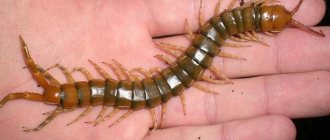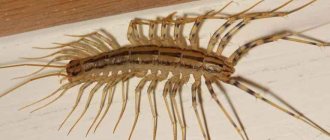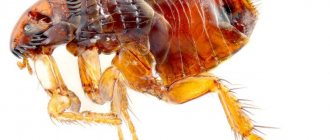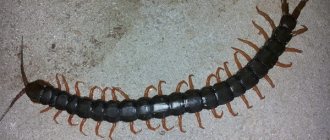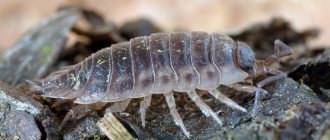Throughout life, the human home attracts many insects, since they can hide in it, spend the winter and find something to eat. At the same time, there is the appearance of many, sometimes dangerous insects, the proximity of which does not bode well. As for the centipede, it is the most harmless creature that can be found in a person’s home. Moreover, such a neighborhood can bring a positive effect, although few people know about it.
Therefore, first of all, the centipede scares apartment residents with its not very attractive appearance: the body is long and sinuous with many legs. Fear arises because practically no one knows what kind of insect this is and what to do with it. This article explains what this insect is and how to deal with it.
What is it like?
The common centipede got its name for a reason. In her case, everything is obvious - many legs do not go unnoticed. Thanks to this, the arthropod runs very fast. In 1 second she covers up to 40 cm. This allows her to quickly hide when danger appears.
If you carefully examine the centipede, you can find small hairs all over its body, and long antennae on its head. There are also stripes running along the body that extend to the paws. Some people associate the centipede with a scary beetle with a flexible, curved body.
The centipede is an ancient and harmless animal
In fact, it is an animal, not an insect. An arthropod that also has other names:
- centipede;
- flycatcher;
- scolopendra.
And she actually has 30 legs, all of which are capable of completely regenerating if injured or lost. There is also a respiratory organ.
Her body consists of segments that allow her to be nimble and agile. The forelimbs have claws for capturing and holding prey, and the remaining legs have sharp spines, with which it easily moves across any surface. Having grabbed onto the victim, the centipede bites it and injects it with paralyzing poison, and then eats it.
But meeting a person for the latter does not pose any particular danger. Except that psychologically her frightening appearance is impressive. Scolopendras come in different sizes - from 2 to 15 cm, but large individuals can hardly be found in human habitats, except in the tropics, and in Russia species larger than 5 cm have not been found.
Flycatchers are predators, and in nature their role is extremely important in maintaining the natural balance and balance of the number of organisms. The name of this living creature speaks for itself - they catch flies, as well as:
- cockroaches and worms;
- midges and moths;
- wood bugs, spiders;
- larvae of other insects.
Without centipedes, it would be more difficult for humans to fight numerous pests of gardens, vegetable gardens, and nature reserves. In total, there are several thousand species of flycatchers in nature, and they are the oldest inhabitants on Earth.
Attention!
A flycatcher can bite a person accidentally. Its poison is not fatal, but the bite can be noticeable depending on the sensitivity of the body. The wound will become red and may hurt. It is enough to treat the bite site with an antiseptic and do not scratch if itching occurs.
Why is it dangerous?
With the appearance of unusual neighbors, people are interested in why centipedes are dangerous. Apart from its frightening appearance, the common flycatcher is absolutely safe for households or their pets. In addition, the centipede prefers to hunt at night, so many people are not even aware of its existence.
If you try to pick up the centipede with your hands, you will likely experience irritation on the skin. This is due to the fact that the flycatcher’s venom transfers to the skin from the paws. Like insect bites, this can cause some discomfort to a person.
But it is easy to get rid of it by placing the limb under a stream of cold water.
Preventive actions
To prevent a centipede from starting up in an apartment, you need to avoid excessive dampness and remember that the creature will not live in a dry room. To do this, the following preventive measures should be taken:
- systematic cleaning of “wet” rooms: bathroom and shower, thorough dry wiping of pipes and tiles;
- timely sealing of cracks and crevices in windows, on the floor, at the joints of water pipes;
- fighting insects in the house;
- destruction of mold in the apartment;
- Do not allow water to stagnate in the trays of flower pots;
- Periodically you need to ventilate and dry your home.
A centipede encountered in one's own apartment often terrifies people. An insect running quickly seems dangerous and aggressive. In fact, such statements have a basis. The centipede insect is a predator; it is indeed capable of attacking and biting, but not a person, but a fly or moth. She tries to avoid contact with people, hiding in hard-to-reach corners. If there is a clear threat, the centipede may bite; the insect's venom causes problems for people with allergies.
What does it look like
Almost everyone knows what centipedes look like. The external structure of centipedes is simple. The body is divided into a separate head and torso, consisting of a varying number of segments.
The head is a fusion of the acron and 4 segments of the body . It also has a pair of antennae and 3 pairs of limbs. In labiopods, the head limbs resemble those found in insects.
The body of an adult centipede reaches a length of up to 60 mm. Basic color: from gray with a yellowish tint to bright brown. 3 purple or blue parallel stripes are visualized on the back.
How many legs
Arthropodologists can tell you how many legs centipedes have. They argue that the number of legs changes dynamically as the flycatcher grows and ages. And their number directly depends on the number of body segments. At first, the newborn centipede has 1 to 4 segments with 4 pairs of striped limbs.
As the body grows, new legs appear . In an adult, there are a maximum of 15 pairs. In this case, the outermost pair of limbs is longer than the others and more closely resembles whip-like antennae.
There's a centipede in the bathroom. Where do small white insects come from in the bathroom?
For people faced with such a problem, the first thing that worries them is the question of where these domestic insects come from.
First of all, it’s worth figuring out what attracts them to the bathroom:
- This is exactly the place where there is increased dampness. For white bugs, such an environment is favorable. In it they can fully exist, feed and reproduce.
- In the bathroom, insects will always find water and food for themselves.
- This is the part of the room where there are almost always no people who can scare you.
- Daylight is an unfavorable area for bugs; they feel more comfortable in the dark.
- Another reason to stay in this place is that there are no pets.
Based on the above factors, we can safely say that the bathtub is the most favorable place for white ill-wishers to live.
Now it’s worth figuring out where they come from into the house. First of all, they can immigrate from basements, attics or neighbors. Not surprisingly, people living on the first or last floor often face this problem. They can also develop independently within the walls of an apartment from larvae.
There are several reasons why they may appear:
- extreme pollution;
- excessive humidity and wet pipes;
- increased air temperature.
To ensure that you never have a problem like insects in your apartment, you should always keep your bathroom completely clean.
How to get rid
Many people are concerned about how to get rid of centipedes in a private home, since they find them on their territory quite often. But there are also those who are interested in how to get rid of centipedes in an apartment.
Arthropodologists argue that it is not necessary to immediately resort to aggressive methods. To begin with, it is advisable to use simple, non-toxic methods.
Folk remedies
When flycatchers appear in an apartment, experienced housewives will tell you what to do. They tried folk remedies from personal experience.
These methods are popular:
- Keeping clean and dry. Centipedes are attracted to moisture. If the room is warm and damp, then arthropods will willingly live there. To remove them, try to wipe dry all wet places in the apartment or house. They also carry out regular cleaning and get rid of fungal growths on the walls.
- Freezing of living space. Family members leave the house or apartment and leave the room without heating for 2-3 days in winter. During this time, not only centipedes die, but also other pests. But since many residential premises use a central heating system, not everyone will be able to use this method of control.
- Use of boric acid. This inexpensive pharmaceutical drug gets rid of insects and rodents. Arthropods such as the centipede are also afraid of it. Fragments of boric acid, when they come into contact with the body of the flytrap or inside, cause a strong burning sensation, causing death.
Experienced housewives also recommend installing fine-mesh grilles on all ventilation openings, which must be cleaned regularly. In addition, it is advisable to make a classic cosmetic repair when peeling wallpaper, cracks in the plaster or fallen tiles appear.
Mechanical methods
Centipedes are interesting arthropods. Some claim that they have a good memory and are able to compare certain events. If you catch several centipedes and then release them on the street far from the house, then the remaining arthropods will also not claim this living space.
But not everyone is so humane towards such creatures, so most often they get rid of them using a fly swatter or slippers.
Chemicals
When resorting to the help of chemicals, it is important to think carefully about how to poison centipedes, since not all the usual poisons that kill harmful insects act on them.
Modern methods of combating centipedes include the following::
- Glue traps. Some try to catch centipedes using this product, which has proven itself in the fight against cockroaches or ants. But doing this is pointless, because even if the centipede falls into a trap and sticks with several legs, it will lose them without regret. This will not prevent her from running, and the damaged limbs will grow back.
- Medilis-Ziper. This toxic agent has proven itself well in the fight against arthropods. It is sprayed using a spray bottle in those places where centipedes run most often. This product is good because it does not harm pets.
- Global Original. The product is available in the form of a paste. It has a toxic effect on many pests. The product has an unpleasant odor, but it is faint, so the paste is used in apartments with pets. The insecticide is applied in a thin layer along baseboards and where centipedes often appear.
If you decide to fight centipedes with toxic drugs, you should take care of your personal safety by using gloves and a protective mask. And before returning to your apartment or house, they should be thoroughly ventilated.
How to poison, remove a centipede from a house or apartment forever: means of control, poison
You cannot poison centipedes; throw them into wet leaves outside the window.
You cannot kill or poison centipedes with various means because of their small number on our Earth . Usually one or several centipedes can wander into a home, and their reproduction occurs in nature.
If you are uncomfortable with a flycatcher, you can catch it in a jar and release it outside in the spring or summer.
Lifestyle
A centipede is an arthropod that has a unique lifestyle, habitat and food preferences.
Where does it live?
The common flycatcher is found where the climate is temperate. Millipedes can live in Europe, the Middle East and northern Africa. They prefer to hide under stones, fallen leaves or plant debris. The house centipede primarily hunts at night.
Common flycatchers flock to people's houses and apartments with the arrival of cold weather.
Choose dark and damp places to live:
- basements;
- bathrooms;
- restrooms.
Despite their appearance, centipedes are not the most harmful living creatures trying to live near humans.
Video
Flycatcher eating
Centipedes in a private house, apartment, why they should not be killed: folk signs
According to folk superstitions, you cannot kill a centipede; if it bothers you, throw it out into the street.
Folk superstitions arose as a result of observations of various incidents in people’s lives over the centuries.
If you believe the signs:
- The appearance of a centipede in the house foreshadows some news or letter.
- To see a centipede running during the day means heavy rain.
- If there are many centipedes in the house, you cannot kill them, but you need to catch one centipede and throw it outside, the rest will run away on their own.
Nutrition
All representatives of the superclass are predators. They usually eat:
- ants and their larvae;
- domestic cockroaches;
- flies, ticks.
Some species, such as the giant and ringed scolopendra, found in South America and Jamaica, are capable of hunting mice, frogs and lizards.
Centipedes use poison to paralyze and kill their victims. However, there is no need to be afraid of them: the poison produced by centipedes is harmful only to small arthropods, but not to mammals. In rare cases, the poison can provoke allergies.
Centipedes feed as follows. Having caught the victim, they inject poison into them and hold it with strong jaws and paws until the insect is completely immobilized. Only after this do they start eating.
Centipedes also destroy insects that harm agriculture. In some countries, for this reason they are under government protection.
Reproduction
Centipedes lead a solitary lifestyle. In May and June they begin their breeding season. At this time, females begin to produce pheromones that attract males.
The fertilization process of centipedes is interesting. First, the male blocks the entrance to his home in the soil and deposits a sac with sperm - a spermatophore - into the resulting shelter. After this, the female crawls under the spermatophore, capturing it with her genital appendage. A few days later she lays eggs in the hole. The female creates a layer of sticky mucus on top of the eggs, which protects the offspring from predators.
One clutch can contain from 60 to 150 eggs. The female does not leave the clutch and drives other insects away from it. To prevent mold from appearing on the eggs, the centipede secretes a special substance whose composition resembles antifungal drugs.
Centipede larvae emerge simultaneously.
